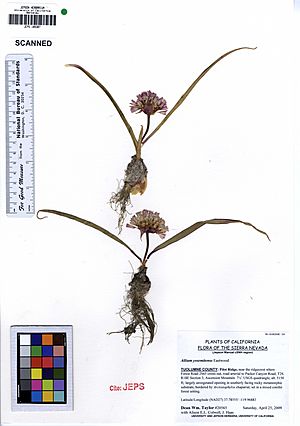Yosemite onion facts for kids
Quick facts for kids Yosemite onion |
|
|---|---|
 |
|
| Allium yosemitense | |
| Scientific classification |
The Allium yosemitense, also called the Yosemite onion, is a type of wild onion. It grows naturally in California. Most of these special onions are found inside Yosemite National Park.
What Does the Yosemite Onion Look Like?
The Yosemite onion grows from a small bulb, like a tiny underground storage unit. This bulb is about two to three centimeters long. From the bulb, a stem called a scape grows upwards. This scape can reach up to about 23 centimetres (9.1 in) tall.
The plant has two long, flat leaves. These leaves are usually a bit longer than the main stem. At the top of the stem, you'll find a cluster of flowers. This cluster is called an umbel. It can hold up to 50 white or pink flowers. Each flower sits on its own small stalk, called a pedicel. These little stalks can be more than 3 centimetres (1.2 in) long.
Where Does the Yosemite Onion Grow?
The Yosemite onion is a plant that is endemic to a specific area. This means it only grows naturally in the central Sierra Nevada mountains of California. You can find populations of this onion in three counties: El Dorado, Mariposa, and Tuolumne. Many of these plants live inside Yosemite National Park.
This special onion grows in several types of natural areas. These include chaparral and foothill woodlands. It also lives in Sierra Nevada lower montane forests, which are sometimes called Yellow Pine Forests. Another habitat is the Mixed Evergreen Forest.
The State of California lists Allium yosemitense as a Rare plant. It is also included in the Inventory of Rare and Endangered Plants of California. This inventory is put together by the California Native Plant Society (CNPS).

